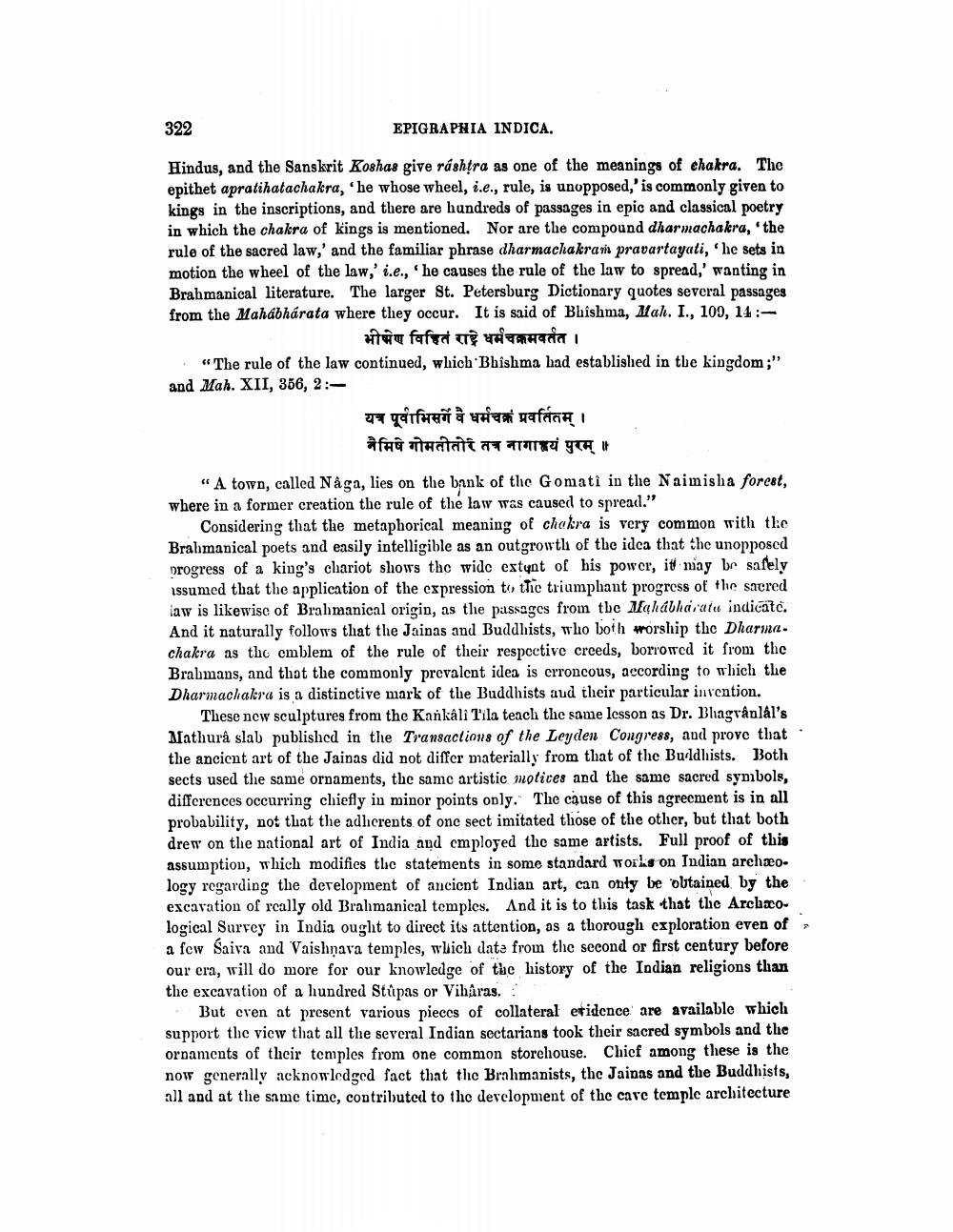________________
322
EPIGRAPHIA INDICA.
Hindus, and the Sanskrit Koshas give ráshtra as one of the meanings of chakra. The epithet apratikatachakra, 'he whose wheel, ie, rule, is unopposed,' is commonly given to kings in the inscriptions, and there are hundreds of passages in epic and classical poetry in which the chakra of kings is mentioned. Nor are the compound dharmachakra, 'the rule of the sacred law,' and the familiar phrase dharmachakram pravartayati, 'he sets in motion the wheel of the law,' i.e., 'he causes the rule of the law to spread,' wanting in Brahmanical literature. The larger St. Petersburg Dictionary quotes several passages from the Mahabharata where they occur. It is said of Bhishma, Mah. I., 109, 14:भीभेण विहितं राष्ट्रे धर्मचक्रमवर्तत ।
"The rule of the law continued, which Bhishma had established in the kingdom;" and Mah. XII, 356, 2:
यत्र पूर्वाभिसमें वे धर्मचक्र प्रवर्तितम् । नैमिषे गोमतीतोरे तत्र नागाह्वयं पुरम् ॥
"A town, called Nâga, lies on the bank of the Gomati in the Naimisha forest, where in a former creation the rule of the law was caused to spread."
Considering that the metaphorical meaning of chekra is very common with the Brahmanical poets and easily intelligible as an outgrowth of the idea that the unopposed progress of a king's chariot shows the wide extent of his power, it may be safely assumed that the application of the expression to the triumphant progress of the sacred law is likewise of Brahmanical origin, as the passages from the Mahabharata indicate. And it naturally follows that the Jainas and Buddhists, who both worship the Dharma. chakra as the emblem of the rule of their respective creeds, borrowed it from the Brahmans, and that the commonly prevalent idea is erroneous, according to which the Dharmachakra is a distinctive mark of the Buddhists and their particular invention.
These new sculptures from the Kankali Tila teach the same lesson as Dr. Bhagvanlal's Mathurâ slab published in the Transactions of the Leyden Congress, and prove that the ancient art of the Jainas did not differ materially from that of the Buddhists. Both sects used the same ornaments, the same artistic motives and the same sacred symbols, differences occurring chiefly in minor points only. The cause of this agreement is in all probability, not that the adherents of one sect imitated those of the other, but that both drew on the national art of India and employed the same artists. Full proof of this assumption, which modifies the statements in some standard works on Indian archæology regarding the development of ancient Indian art, can only be obtained by the excavation of really old Brahmanical temples. And it is to this task that the Archæological Survey in India ought to direct its attention, as a thorough exploration even of a few Saiva and Vaishnava temples, which date from the second or first century before our era, will do more for our knowledge of the history of the Indian religions than the excavation of a hundred Stupas or Vihâras.
But even at present various pieces of collateral evidence are available which support the view that all the several Indian sectarians took their sacred symbols and the ornaments of their temples from one common storehouse. Chief among these is the now generally acknowledged fact that the Brahmanists, the Jainas and the Buddhists, all and at the same time, contributed to the development of the cave temple architecture




